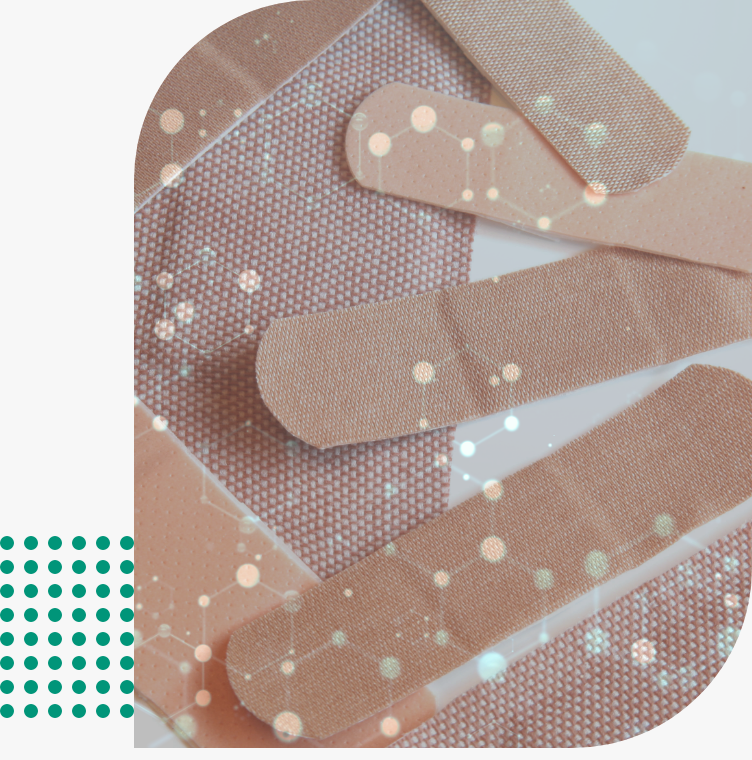Skin Contact Adhesives
Skin contact adhesives are both common and innovative. Any adhesive that is applied directly to the skin falls under this broad term. While the bandages in the bathroom door used for minor cuts and scrapes seem simple, there is decades of research in every box. The athletic tape used to support joints and muscles is rooted in the same skin contact adhesives used in the most advanced trauma care. The adhesives that help reduce blisters have similarities with state-of-the-art negative wound therapy. Skin contact adhesives are used in every medical application including securing bandages, IV lines, and monitoring devices.
While direct skin contact adhesives are ubiquitous with medicine, the range of adhesives continues to evolve. For over 30 years, silicone adhesives have helped broaden the technology and capabilities of skin contact adhesives. Polymer Science helps manufacturers both with medical grade adhesives and adhesives for bonding skin contact devices. With the wide range of tapes, adhesives and coatings suitable for skin contact, manufacturers benefit from working with our experienced team.
Common Varieties of Skin Contact Adhesives
The qualities and characteristics of skin are unique. Constant motion, external forces and the constant change and regeneration of skin demand specific adhesives. The purpose of the application also affects the preferred type of skin contact adhesive. Medical issues like abrasions, burns, sensitive skin and wounds require the adhesive to be safe and non-irritating to the skin. They must also be able to withstand the forces that are applied to them during use.
The most common types of skin contact adhesives are:
Acrylic adhesives
Acrylic and medical grade adhesives are durable and have a proven compatibility with skin. Acrylic skin contact adhesives exhibit strong initial tack to porous and non-porous material. Acrylic adhesives are a cost-effective solution often used to secure IV lines, catheters and generation fixation to skin. They can be laminated to many surfaces including films, foams and fabrics.
While acrylics are conventional, there continues to be innovations. For example, low-trauma acrylic adhesives behave similarly to a silicone gel adhesive promoting atraumatic removal at a more economical cost than silicone and hydrogel adhesives.
Hydrogel adhesives
Acrylate based hydrogel adhesives are used in medical and cosmetics. Highly flexible and conformable to the skin surface, hydrogels are biocompatible with the skin. For wounds including burns, the long-term wear and atraumatic removal are valuable.
Silicone gel adhesives
Soft and comfortable to wear, these polymers are non-irritating to the skin. Silicone gel adhesives are often used to secure bandages and wound dressings. Gentle, repositionable and resistant to bacterial growth, silicone skin contact adhesives offer many benefits for wearables, scar therapy, drug delivery and other medical applications.
Choosing the Best Skin Contact Adhesive
Polymer Science offers P-DERM® medical grade skin contact adhesives ranging from conventional acrylics and medical grade adhesives to our innovative atraumatic, pain-free removal silicone gel and hydrogel adhesives. There are many different formulations because the demands of the medical industry are constantly changing. To meet the requirements of your application, Polymer Science encourages manufacturers to work with our team from concept through the aftermarket phase.
Medical Wearable Devices
A key example of how Polymer Science benefits manufacturers is in advancements in medical wearable devices including continuous glucose monitoring. The term medical device refers to a range of devices that may or may not require adhesion to the skin. Polymer Science offers a variety of adhesive chemistries which can perform the function of a skin contact adhesive or a device’s construction adhesive. The importance of working with an experienced and knowledgeable supplier for skin contact adhesives is exemplified with medical wearable devices. When manufacturers are designing new products for direct skin contact, there are potential risks and obstacles between conception and production. This is the inherent challenge of any design and development project.
In the case of medical wearable devices, finding the most suitable skin contact adhesive during the design phase is extremely beneficial. Adhesive chemistries such as silicone gel adhesives, acrylic and hot melt pressure sensitive adhesives and hydrogels are used as transfer adhesives for single-face and double-adhesive-faced products. In the case of medical devices, trilaminate constructions may be used. Adhesives may interact with the device, other adhesives and the skin. Skin contact adhesives may also suit the manufacturing process and may need to adhere to multiple substrates. Most importantly, the adhesive must match the characteristics of the skin for the device to work properly. Bodies are in constant motion and subject to a number of contaminants. If the device moves due to the wrong adhesive, readings can be wrong or the device may fall off the skin entirely.
Polymer Science works with manufacturers to find the best solution. In the case of P-DERM® skin contact adhesives for Continuous Glucose Monitoring, Polymer Science worked with the leading CGM makers and developed silicone gels for CGM device fixation. With a greater risk of allergic reaction to conventional acrylic adhesives, Polymer Science developed skin contact silicone adhesives that negate the problem. The hypoallergenic silicone gel adhesive layer offers a wear time above 14 days, is resistant to bacterial growth, is waterproof and provides atraumatic removal.
How Polymer Can Assist Manufacturers
Polymer Science is committed to helping manufacturers with a consistent supply of a wide range of skin contact adhesives. We also provide P-DERM® Custom Solutions. This 5 phase process is proven to help find the custom coatings, adhesives, carriers and backings for your specific application.
- Defining the Project – When you contact Polymer Science, our sales team gathers information to define the scope of the project and the design criteria.
- Design & Assess – After project development, you will access our diverse team of engineers. Together, we develop and, if necessary, modify the original solution to ensure you are provided with the best product possible with product and manufacturing feasibility.
- Verification & Validation – Polymer Science determines the reproducibility and repetition of the manufacturing process.
- Commercialization – At this stage, development is complete and the process is then transferred to our highly skilled sales and operations teams.
- Aftermarket Support – To ensure the success of your product, our technical services, engineering and quality teams work with you to ensure our material continues to meet the form, fit and function demands of your target market.
To learn more about our P-DERM® skin contact adhesives, contact us today.

